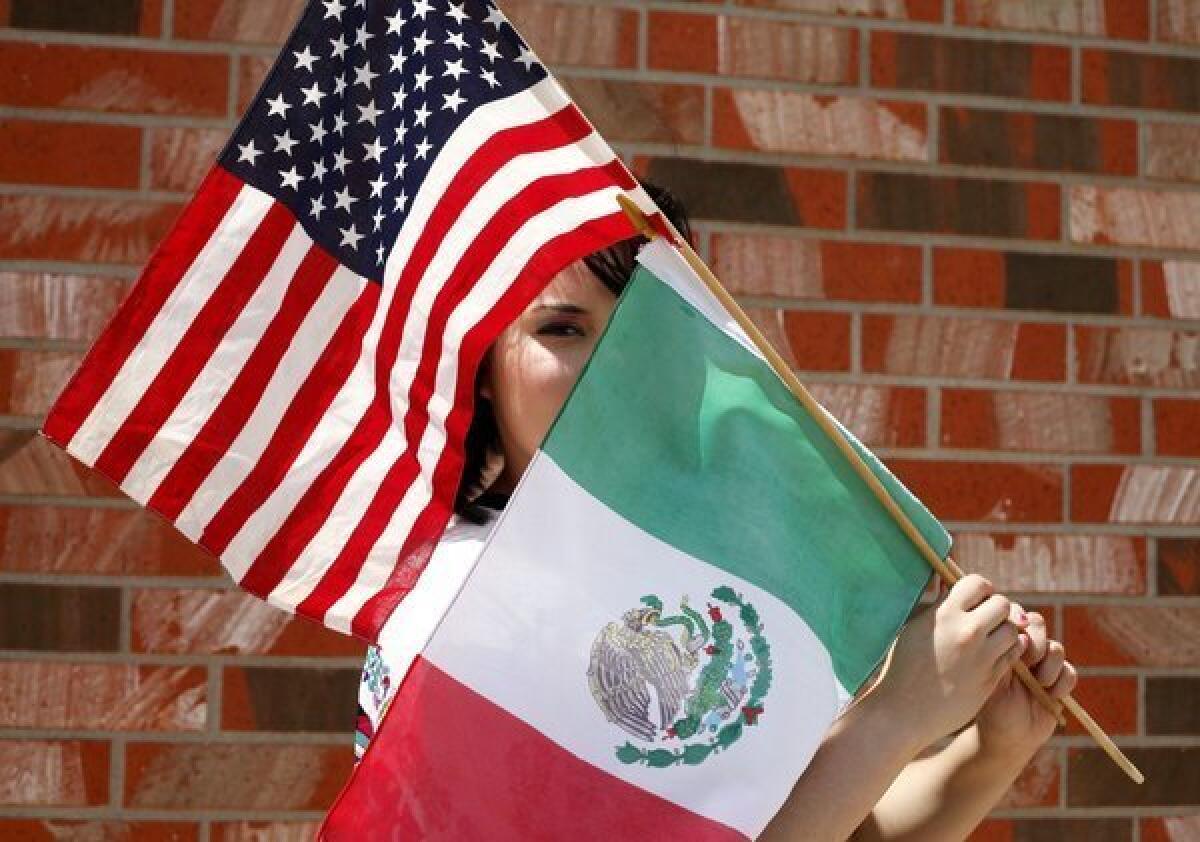Mexican American mobility

Now that the Senate has passed its immigration bill, the future of reform lies in the hands of the GOP-led House, where the debate will center on allowing a path to citizenship for 11 million immigrants living in this country without legal status. Opponents of this path often claim that low-skilled Mexicans, who make up the largest subgroup, are not fitting into U.S. society — that they don’t want to assimilate and are fated to remain a permanent underclass.
Solid evidence suggests these claims are untrue. Many Mexican immigrants and their children have traveled paths to becoming full Americans that, even if slower, are not unlike the paths followed previously by European immigrants. And when parents have legal status, their children do better in school and become fully productive members of American society more quickly.
For social scientists, the question of immigrant assimilation is testable. By observing the experiences of Mexican immigrants from first-generation new arrivals through their second-generation children, third-generation grandchildren and so on, the extent to which they become similar to people in the rest of society and integrate into the mainstream becomes apparent.
U.S. IMMIGRATION LAW: Decades of debate
For Mexicans, who have been immigrating to the United States for a century, the historical moment of arrival and the number of generations removed from the immigrant generation are crucial parts of the story. When accounting for both, the best analyses suggest cautious optimism. Each passing generation of Mexican Americans does better than the one before at making economic gains and progressing toward full integration into U.S. society.
One comprehensive study published in 2008 tracks Mexican Americans’ experiences in the large Mexican centers of Los Angeles and San Antonio, where sociologists Edward Telles and Vilma Ortiz found significant and steady upward educational mobility. On average, first-generation parents completed just 4.1 years school in the 1900s to 1930s. Their second-generation children completed 10 years in the 1930s to 1950s, and their third-generation grandchildren completed 13.1 years of school in the 1950s to 1980s. Later-generation Mexican Americans also narrowed the gaps in educational attainment with non-Latino whites to 1.3 years from 3.4 years.
Those historical findings are echoed in another study by Julie Park, Dowell Myers and Tomás Jiménez that looked at more recent Mexican immigrants. In 1980, just one-fifth of immigrants ages 25 to 44 had completed high school. In 2005, when second-generation children of immigrants reached the same age range, more than four-fifths had graduated. Similar generational improvements also were seen in wages earned, rates of homeownership and percent living above the poverty line. The gaps between Mexican immigrants and non-Latino whites declined from the first to second generation in all areas (except for homeownership, where no gap exists).
SPECIAL REPORT: Is the border secure?
Rates of intermarriage reflect declining social barriers between groups perhaps more than any other indicator. Across generations, Mexican Americans increasingly marry partners from other ethnic and racial backgrounds, usually non-Latino whites. Even in Los Angeles and San Antonio — where many people of Mexican heritage live, thereby increasing chances for marriages within the ethnic group — roughly 1 in 3 third- and fourth-generation Mexican Americans are married to someone from another background.
No one should underestimate the challenges Mexicans from a humble background face when they move to the U.S. — especially in today’s economy, in which low-skilled jobs are scarce. Their children can face ethnic prejudices. They often do not have access to top-quality education.
But even in light of the struggles, it is important to highlight the progress of many Mexican Americans. Indeed, they have made this uphill climb in spite of greater challenges than those faced by earlier, European immigrants. An extensive historical study published by sociologist Cybelle Fox in 2012 shows that Europeans who came at the turn of the 20th century were far more likely to receive government aid than Mexicans or blacks, regardless of need. Local relief officials also protected European immigrants from federal agents who were investigating public aid recipients during the Depression. In stark contrast, officials repatriated Mexican immigrants and their U.S.-born offspring, who also faced Jim Crow-like racism in many parts of the country.
For contemporary Mexican immigrants and their U.S.-born children, the biggest challenge to assimilation is illegal status. A 2012 study by sociologist Roberto Gonzales shows that illegal status prevents aspiring immigrant youths from attending many U.S. colleges or working in the jobs they have been preparing for. After high school, their fortunes converge with those of less-educated immigrants, and their belief that hard work and good grades will pay off shatters.
The chance to obtain legal status would clearly improve these youths’ psychological and economic prospects. Recent research by sociologist Frank Bean and colleagues at UC Irvine shows that legalizing the status of Mexican newcomers — a central tenet of the Senate bill — is one of the best ways to encourage and accelerate their progress. In Los Angeles, the child of a Mexican mother here without legal status attains, on average, just 11.5 years of schooling — in other words, he or she drops out of high school. But a child of comparable background whose Mexican mother has been able to legalize her status finishes, on average, 13 years — enough to graduate from high school and get some college-level training. Legalization was also shown to slightly raise the educational levels of these immigrants’ grandchildren.
So whatever the rhetoric, the House needs to realize this: When Mexicans have the opportunity to live and work legally in the United States, the new arrivals and their descendants are more likely to overcome disadvantages and, as immigrants have always done, become strong and constructive contributors to our diverse society. Don’t stand in the way.
Helen B. Marrow is an assistant professor of sociology and Latin American studies at Tufts University, and Tomás R. Jiménez is an assistant professor of sociology at Stanford University. Both are members of the Scholars Strategy Network.
More to Read
A cure for the common opinion
Get thought-provoking perspectives with our weekly newsletter.
You may occasionally receive promotional content from the Los Angeles Times.










